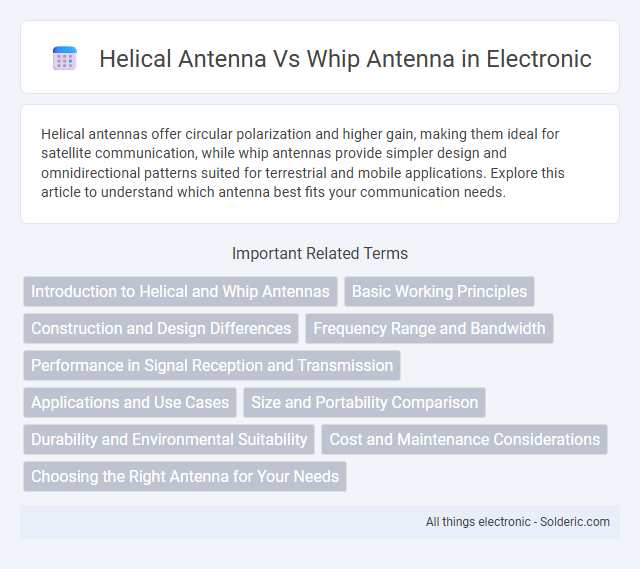Helical antennas offer circular polarization and higher gain, making them ideal for satellite communication, while whip antennas provide simpler design and omnidirectional patterns suited for terrestrial and mobile applications. Explore this article to understand which antenna best fits your communication needs.
Comparison Table
| Feature | Helical Antenna | Whip Antenna |
|---|---|---|
| Design | Coiled wire forming a helix | Straight, flexible rod |
| Polarization | Circular or axial | Linear vertical |
| Gain | High (6-12 dBi) | Low to moderate (2-5 dBi) |
| Bandwidth | Wide bandwidth | Narrower bandwidth |
| Size | Bulkier, longer length | Compact, lightweight |
| Applications | Satellite communication, space telemetry | Mobile radios, portable devices |
| Radiation Pattern | Directional, focused beam | Omnidirectional |
| Impedance | ~140 O | ~50 O |
| Complexity | More complex design | Simple design |
| Cost | Higher due to design complexity | Lower, economical |
Introduction to Helical and Whip Antennas
Helical antennas feature a spiral wire wound in a helix shape, offering circular polarization and broad bandwidth ideal for satellite and communication applications. Whip antennas are straight, flexible rods known for their simplicity, ease of deployment, and effectiveness in VHF and UHF frequency ranges. Your choice between these antennas depends on application requirements such as polarization, gain, and size constraints.
Basic Working Principles
Helical antennas operate by winding a conducting wire into a helix shape, producing circularly polarized radio waves ideal for satellite communication and GPS. Whip antennas function as simple, straight wires that radiate linearly polarized waves, commonly used in mobile and portable radio devices. Your choice between these depends on the need for polarization type, bandwidth, and specific application requirements.
Construction and Design Differences
Helical antennas feature a wire wound in a helix shape around a central axis, often mounted above a ground plane to enhance directivity and gain, whereas whip antennas consist of a straight, flexible rod typically functioning as a monopole with omnidirectional radiation patterns. The helical design supports circular polarization and higher bandwidth, achieved through parameters like helix diameter, pitch angle, and number of turns, while whip antennas rely primarily on length and material to determine resonant frequency and efficiency. Construction materials differ as well, with helical antennas using rigid frames to maintain precise geometry, contrasting with the simpler, lightweight build of whip antennas designed for ease of installation and portability.
Frequency Range and Bandwidth
Helical antennas operate efficiently over a wide frequency range, typically from VHF to UHF bands, offering broader bandwidth due to their spiral design that supports circular polarization. Whip antennas generally cover a narrower frequency range, primarily within VHF or UHF, with limited bandwidth constrained by their linear monopole structure. Your choice between these antennas should consider the required frequency coverage and bandwidth to ensure optimal signal performance in your application.
Performance in Signal Reception and Transmission
Helical antennas offer superior signal reception and transmission with their ability to provide circular polarization, reducing multipath interference and enhancing signal clarity in complex environments. Whip antennas, typically linearly polarized, perform well in simple line-of-sight conditions but may suffer from reduced signal quality in urban or obstructed areas. Your choice depends on the need for robustness in signal reception and transmission, where helical antennas excel in reliable, high-quality communication.
Applications and Use Cases
Helical antennas excel in satellite communication, GPS systems, and space telemetry due to their circular polarization and wide bandwidth capabilities, making them ideal for both transmitting and receiving signals in dynamic environments. Whip antennas are commonly used in mobile and portable applications, such as two-way radios, automotive communication, and handheld devices, thanks to their simple design, durability, and ease of installation. Your choice between a helical or whip antenna should consider the specific application requirements, including frequency range, polarization, and physical constraints.
Size and Portability Comparison
Helical antennas are generally larger and bulkier due to their spiral wire design, making them less portable than whip antennas. Whip antennas are characterized by their slim, straight rod structure, which enhances ease of transport and quick deployment in various field applications. Size constraints often dictate whip antennas as the preferred choice for handheld devices and mobile communications requiring compactness and lightweight features.
Durability and Environmental Suitability
Helical antennas exhibit superior durability due to their rigid coil structure, making them highly resistant to physical stress and environmental factors such as wind and vibration. Whip antennas, typically composed of flexible metal rods, offer moderate durability but are more prone to bending and damage under harsh conditions. Helical designs are preferred for outdoor and mobile applications requiring reliable performance in diverse environmental settings.
Cost and Maintenance Considerations
Helical antennas generally incur higher initial costs and require more maintenance due to their complex structure and precise tuning needs, making them less suitable for budget-conscious applications. Whip antennas offer a cost-effective alternative with simpler construction and minimal maintenance requirements, ideal for widespread, low-maintenance deployments. The choice between the two often depends on balancing performance benefits against long-term maintenance budgets and operational costs.
Choosing the Right Antenna for Your Needs
Helical antennas offer circular polarization and higher gain, ideal for satellite communication and applications requiring robust signal reception. Whip antennas provide omnidirectional coverage and ease of installation, making them suitable for mobile and handheld devices. Selecting the right antenna depends on factors such as signal directionality, frequency range, and the specific communication environment.
helical antenna vs whip antenna Infographic

 solderic.com
solderic.com